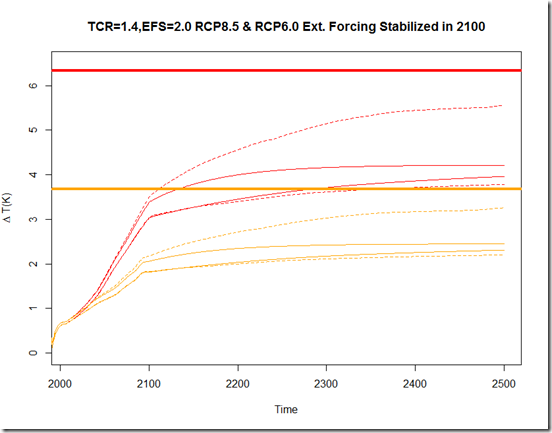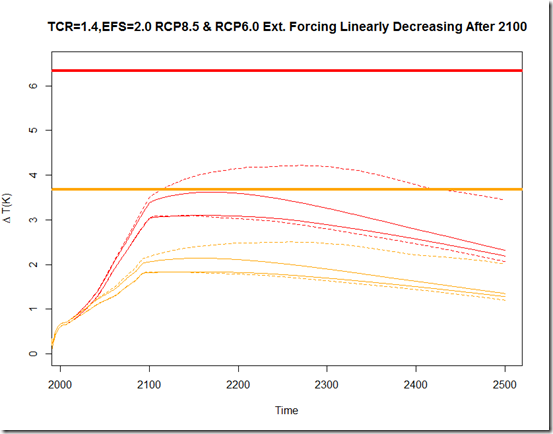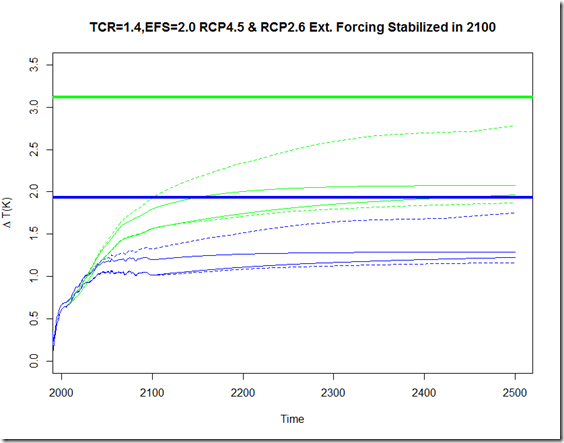A paper by Kummer and Dessler (2014) [KD14] has recently been accepted by GRL, with the primary claim being that observational estimates of ECS over the 20th century can be reconciled with the higher ECS of CMIP5 models by accounting for the “forcing efficacy” mentioned in Shindell (2014):
Thus, an efficacy for aerosols and ozone of ≈1.33 would resolve the fundamental disagreement between estimates of climate sensitivity based on the 20th-century observational record and those based on climate models, the paleoclimate record, and interannual variations.
However, I think there is some fundamental confusion with respect to how the forcing enhancement should be applied within KD14, which I will focus on specifically for this post (ignoring what I believe to be other issues in the actual energy balance calculations for the mean time). While I have noted previously that the spatial warming pattern appears to indicate a value of “E” (the Shindell enhancement) near unity, I would submit that even if it was significantly greater than 1.0, it has been applied in a way within KD14 that likely substantially exaggerates its effect on 20th century ECS calculations. Here are the issues that I see:
1. ECS calculations are unaffected by the effective heat capacity, whereas TCR calculations are not
First, let’s take a look at the Shindell (2014) definition for the forcing enhancement (which KD14 refers to as “forcing efficacy”), which is the ratio of the inhomogenous forcing TCR to that of the homogenous forcing TCR:
(Eq. 1)
TCR is calculated by dividing the temperature change by the forcing, without consideration of the TOA energy imbalance at the time of the calculation (this is often normalized to transient change for a doubling of CO2 by multiplying by F_2xCO2 (~3.7 W/m^2), but I will leave it simply in the units of K/(W/m^2) for this post):
(Eq. 2)
And if we consider the simple one box temperature response to an imposed forcing at time t, we have:
(Eq. 3)
Where F is the imposed forcing change, lambda is the strength of radiative restoration (the increase in outgoing flux per unit of surface warming), and C is the effective heat capacity of the system. As can be seen by working back from equation 3 to 1, TCR and hence E will be affected by both the difference in C (the heat capacity) and lambda (radiative restoration) between the homogenous and inhomogeneous forcings. On the other hand, the equilibrium response (t –> infinity) to a forcing does NOT depend on C, only lambda.
If we go back to the simple energy balance equation for the top of the atmosphere (TOA) , re-arranging eq. 1 in KD14 to solve for lambda (with N representing this net TOA imbalance), we have:
(Eq. 4)
which can then be inverted and multiplied by F_2xCO2 to find the ECS in terms of a CO2 doubling. What should be quite clear from this determination of ECS is that one can dampen the transient temperature response by increasing the value of C without it affecting the estimate of ECS. After all, If the temperature response is heavily damped in the first 50 years for a forcing (due, for example, to the bulk of that forcing being concentrated in an area with deep oceans), then it is true that the value for T will be lower than it might be for a scenario with less ocean damping, but the TOA imbalance (N) will be larger due to less radiative response (from lambda * T), thereby decreasing the quantity (F-N) by the same ratio , and yielding the same value for lambda. On the other hand, it is clear why such ocean damping *would* affect the TCR, which does not take into account the TOA imbalance (N).
The problem should thus be obvious: the “enhancement” factor calculated by Shindell (2014) can be greatly affected by the difference in effective heat capacity of the hemispheres, but this in itself would not create any bias in the ECS calculations. So KD14 should certainly not be using the forcing “enhancement” factor of Shindell as a proxy for the equilibrium forcing efficacy! Note that much discussion regarding Shindell (2014) focused on how the greater land mass of the NH corresponds to a lower heat capacity, thus producing a greater transient response for an aerosol forcing located primarily in the NH. But this intuition has nothing to do with a bias in the equilibrium response.
Rather, as I mentioned above, E is affected by both the effective heat capacity differential (C) and the increase in outgoing flux per unit increase in temperature (lambda), only the latter of which actually affects ECS. So the more we find that E is a result of the differing heat capacity, the less room that leaves for lambda to have a substantial effect, and the less bias this would actually produce in the ECS estimates. Furthermore, there seems to be less of the way in intuition of why a differing lambda would be responsible for a substantial portion of E, if this were the case. Nevertheless, it IS possible that for a larger E, at least some portion of this would come from a differing radiative response strength from homogenous and inhomogenous forcings, but that leads to the second issue…
2. The Forcing Efficacy “correction” in the estimate is applied directly to the TOA imbalance resulting from the forcing, thereby overcompensating in transient estimates
Per KD14, we read that:
To test the impact of efficacy on the inferred λ and ECS in our calculations, we multiply the aerosol and ozone forcing time series by an efficacy factor in the calculation of the total forcing.
What Kummer and Dessler (2014) have done here is simply inflated the magnitude of the aerosol and ozone forcings beyond the best estimates, rather than actually accounting for the forcing “efficacy” that may result from differing lambdas. In the event that the TOA imbalance has already reached equilibrium, there is no need for this distinction. But in transient runs, using the KD14 method will bias the ECS high, because it is compensating for the differing TOA response in the numerator of Eq. 4 that has not yet fully manifested!
Consider an example, where lambda is 1.5 W/m^2/K for GHG (~2.5 K “true” ECS), but the “forcing efficacy” for aerosols is 1.5 and entirely comes from differing lambda, such that lambda for aerosols is 1.0 W/m^2/K. Now suppose we perform our calculation early on in the transient run, such that only 50% of the equilibrium response to a given forcing of 2.0 W/m^2 GHG and –1.0 W/m^2 aerosols has been achieved. This will yield T_GHG = 2.0 / 1.5 * 50% = 0.67 K, and T_aero = –1.0 / 1.0 * 50% = –0.5 K, for a net T of 0.17 K. Using the KD14 method with Eq. 4, we would have an F = 2.0 W/m^2 – 1.5 * 1.0 W/m^2) = 0.5 W/m^2, an N of (2.0 W/m^2 – 1.0 W/m^2) – [0.67 K * (1.5 W/m^2/K) + (-0.5 K) * (1.0 W/m^2/K) ]= .495 W/m^2, leading to a lambda of (0.5 – 0.495) / (0.17 K) = 0.03 W/m^2/K, corresponding to a sensitivity of > 100K! This extreme example highlights the large bias that the KD14 method can produce when applied to transient runs. Currently, if one takes the last decade net TOA imbalance to be ~ 0.6 W/m^2, and the forcing up to now to be ~ 2.0 W/m^2, this implies we are about 70% equilibrated…under these circumstances I would still expect a large bias from the KD14 application.
Anyhow, to illustrate the bias we would expect from the different methods of calculating ECS given an E of 1.5, I have written a script here. Essentially, it treats the two hemispheres as separate one-box models, with the historic non-GHG anthropogenic forcings applied entirely to a more sensitive NH. I have tried to match this to some degree so that the ending TOA imbalance is around 0.5 W/m^2 (and hence around 70% equilibrated), similar to that observed, but it is also possible that these models have oversimplified things. Nevertheless, here are the results:
What this illustrates is much of the intuition we have gone over in these two sections. From the blue line, we see that as we increase the attribution of the calculated E to the heat capacity differential, there is very little bias introduced when calculating ECS using the “traditional” energy balance method (per #1 above, this is because there is less attributable to the difference in lambda) . On the other hand, since we introduce a case here where we are still far from equilibrium, the KD14 method creates an overestimate in all cases.
Summary
Overall, I am quite dubious about the KD14 results, for 3 reasons:
1) Based on the observed spatial warming, it seems unlikely that E is far from unity.
2) Even if E were greater than 1.0, only a fraction of that E applies to ECS estimates (the portion stemming from differential lambdas and NOT heat capacities), and
3) Even if the full E did apply, it appears KD14 has applied it incorrectly, introducing a large overestimate in the transient cases
The shame of it all is that this actually hints at an interesting underlying question, which is whether the spatial pattern of warming in the real world has created a radiative response substantially different from the response expected from a uniform GHG forcing. It seems that if one were interested in what models say, however, it could be calculated much more directly – comparing the AMIP simulated radiative restoration strength to that of the historicalGHG from the same models would likely be the way to begin along this path.




